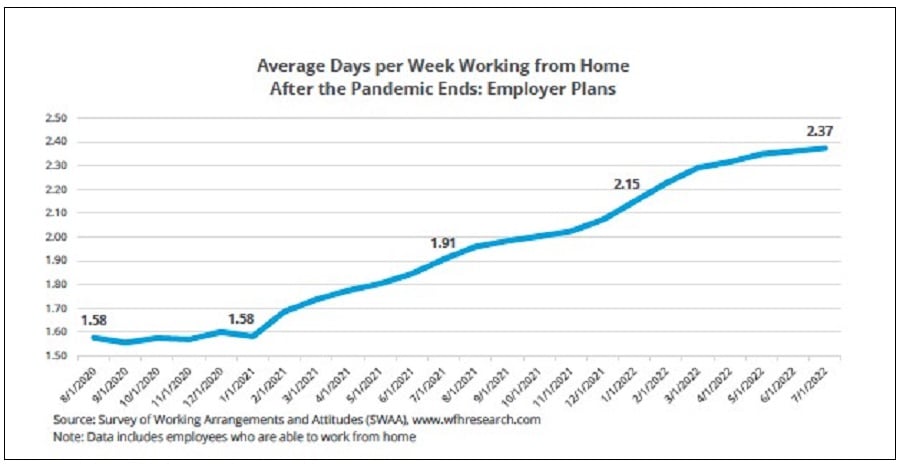In spite of many efforts to bring employees back to the office by prominent companies like Salesforce, Apple, Google, and Tesla, return to the corporate office has remained extremely low by historical standards, even though the fear of COVID is no longer a major issue. Commute time, gas prices, and quality of life are the main factors playing into employees’ decisions to stay home for work.
According to Kastle Systems, which tracks office utilization rates in buildings where they monitor card swipes, office occupancy fell to 14.6% in April 2020*. These buildings are located principally in San Francisco, San Jose, Los Angeles, D.C., New York, Chicago, Houston, Dallas, and Austin. The Kastle Systems swipe data shows occupancy stable at 43-44% since April, an increase from the low point of April 2020, but less than half of what it was pre-pandemic, in spite of efforts from their companies to bring them back to the office.
It has been a struggle for the C-suites. Many companies, like Apple or Google, have deferred the dates of mandated return to the office multiple times. The opposition from employees is stronger than ever. A PWC survey performed in the Spring of 2022 indicates that two third of workers whose jobs can be performed remotely (a vast majority of professional jobs) prefer hybrid work (a mix of work-from-home and work at the office). A large majority said that they would look for another job if not permitted to work from home at least some of the time.
Google called employees back to the office for three days a week in April, but 15,000 of their 165,000 employee workforce requested to work remotely full time.*
As a result, the downtown areas of large cities like New York, San Francisco, and Los Angeles have not recovered many of the small businesses that closed their doors during the pandemic. In their recent Future of The Office in the Age of Hybrid Work report,*Colliers indicates that 26,300 small businesses closed permanently from April 2020 to March 2021 in New York City alone.
In spite of the opposition of many prominent CEOs like Jamie Dillon at JP Morgan or Elon Musk at Tesla, employees are making long-term plans to work from home at least two days a week… or leave their companies.
A report from Morning Consult found that 48% of tech workers are now fully remote, or more than double what it was pre-pandemic.

As a result, companies are continuing to shed space by not renewing leases or attempting to sublease an ever-growing inventory in large downtown areas, more than twice as much in 2022 than in 2019.
When they can’t convert their office building into a residential development, many landlords are converting some of that vacant space into flexible office spaces, partnering with coworking operators to manage the space. As companies reduce their footprint, the need for highly flexible space to support their workforce increases. Many operators, like Pacific Workplaces and Industrious, but also IWG are growing their brand in new locations under management contracts or joint venture agreements with landlords.
While the future of traditional space looks bleak, the future of coworking is shining bright!
*Much of the data and analyses used in this article came from the Colliers report entitled “The Future of The Office in the Age of Hybrid Work.”

